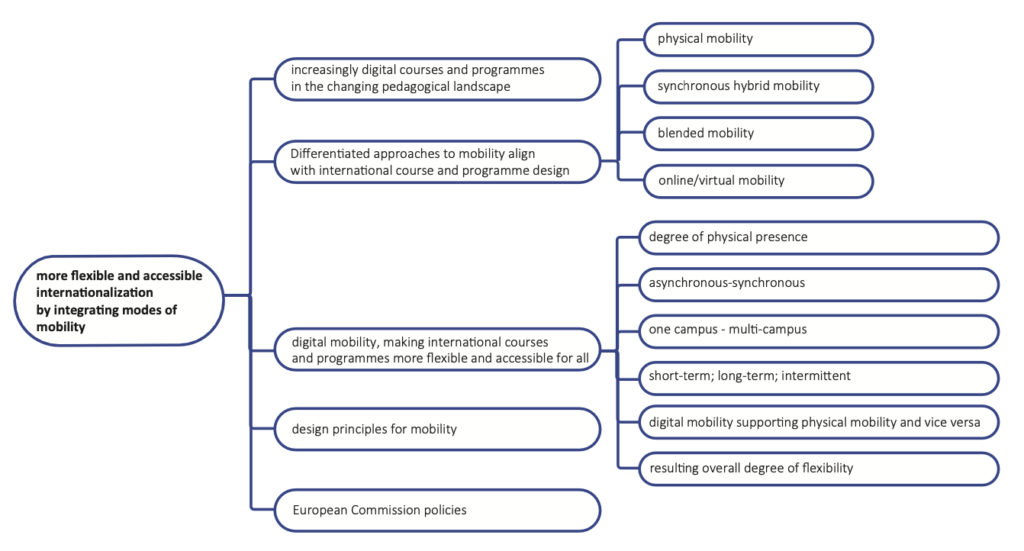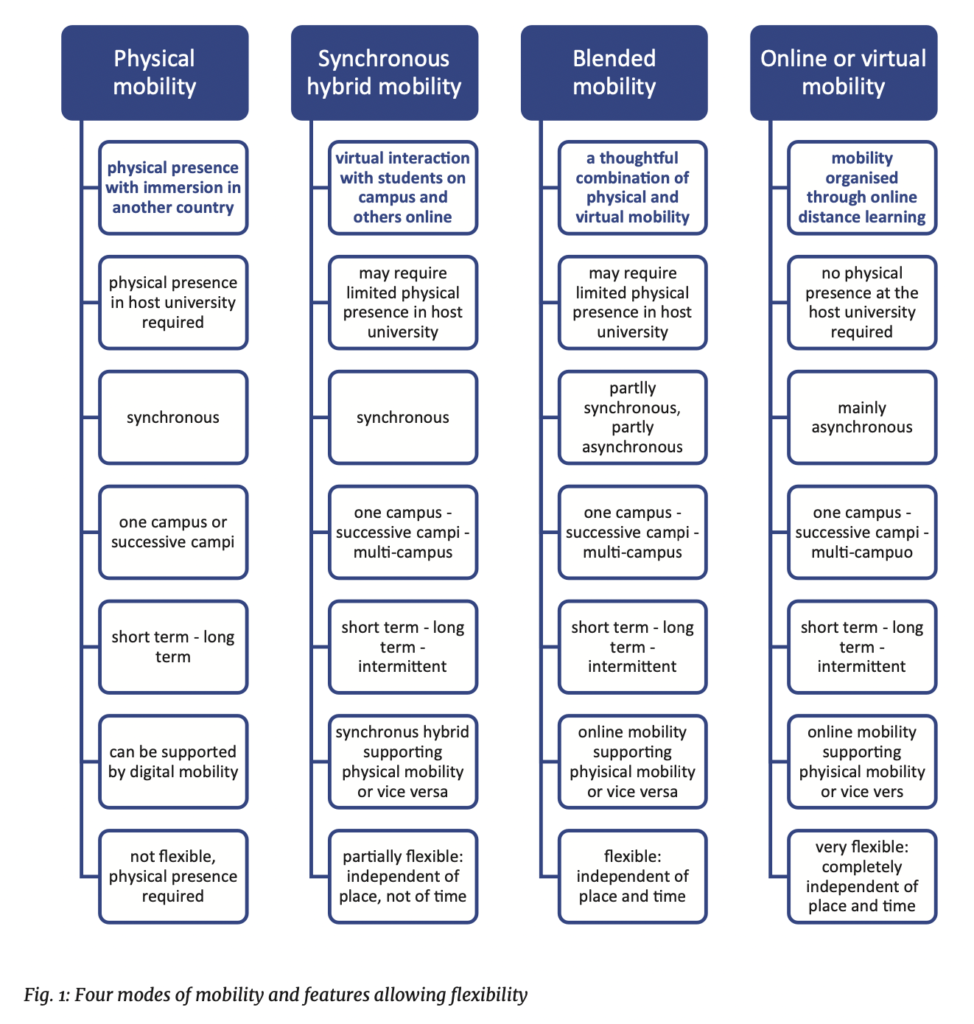
| Digital mobility will make international courses and programmes more flexible and accessible for all: |
| • increasingly digital courses and programmes in the changing pedagogical landscape; |
| • differentiated approaches to mobility align with international course and programme design |
| • digital mobility, making international courses and programmes more flexible and accessible for all; |
| • design principles for mobility; |
| • European Commission’s policies. |
Digital education in the changing pedagogical landscape
Following the emergency practices during the Corona crisis, innovative digital pedagogical approaches will be further developed in European universities and widely used according to up-to-date teaching and learning design principles (see eBook on Digital Teaching and Learning).
Three main design approaches are put into practice in parallel, but can also be combined in a course or curriculum (Pieters et al., 2021):
• Synchronous hybrid teaching and learning: based on settings that have in common that both on-site or ‘here’ students and remote or ‘there’ students are included simultaneously (Raes et al., 2020; Raes, 2020);
• Blended teaching and learning: with a deliberate mix of synchronous and asynchronous methods, based on a course design with a deliberate combination of online and offline learning activities (Biggs, 2002; Garrison &Vaughan, 2013; Goeman et al., 2019, 2021; Dijkstra & Goeman, 2020; van Valkenburg et al., 2020);
• Asynchronous online and distance teaching and learning: based on a course design with a continuous physical separation between teacher and student (Martin et al., 2020; Mathes, 2018)
With the increasing number of digital courses and training, universities have the opportunity to extend mobility schemes to digital mobility.
Differentiated approaches to mobility align with international course and programme design
Mobility naturally goes hand in hand with teaching and learning in courses or programs at the host university (EADTU, 2020a). Mobility can thus be organized in the following main modes:
• Physical student mobility, involving immersion in another country;
• Synchronous hybrid mobility, involving international interaction with students both on campus and others online;
• Asynchronous online/virtual mobility, organized between universities through online distance learning;
• Blended mobility, with a thoughtful combination of physical and online/virtual mobility.
Digital courses create more opportunities for differentiated policies and strategies for international cooperation and mobility, making education more flexible in terms of place, time, pace and content of learning and therefore more scalable and adaptable to the learners.
Digital mobility, making international courses and programmes more flexible and accessible for all

Different modes of mobility result in specific possibilities for flexible collaboration as shown in fig. 1:
• Digital mobility modes require limited or no physical presence in another country;
• Blended and online/virtual mobility modes can be organized partially or completely asynchronously. Not or less for synchronous hybrid mobility;
• Digital mobility modes can reach more than one campus at a time;
• Digital mobility modes can be easily organized into different time intervals;
• Digital mobility modes can support physical mobility and vice versa;
This leads to different degrees of flexibility: more physical mobility is less flexible, fully online/virtual mobility will be the most flexible. Synchronous hybrid and blended mobility are in between.
In practice, different modes of mobility can be combined according to the design of courses and programs and the mobility agreements between universities.
Blended and online/virtual mobility enables teaching and learning in very large or very small groups and differentiating content in adaptable mobility paths. This would be less the case with physical mobility.
Making international collaboration and mobility flexible is likely to be a groundbreaking solution to create mobility for all, especially for university alliances that aim for 50% mobility of their students in combination with their green campus policy.
Design principles for mobility
In the future, mobility agreements and the design of mobility can be based on following principles (EADTU, 2020a):
• In the new European pedagogical landscape, education is organized in face-to-face, synchronous hybrid, blended or online modes. Mobility modes are linked to course and program design and are to be aligned with course objectives and learning outcomes;
• Mobility can be short, medium or long term;
• Mobility can be synchronous and asynchronous;
• ICT teaching and learning methods enhance the potential of education and mobility by creating flexibility (independence of place, time, pace, differentiated content and mobility paths);
• All forms of mobility can be offered separately or in combination;
• None of the forms of mobility is an alternative to replacing the others. Each form contributes to the enrichment of education and offers students the opportunity for international learning;
• The design and sequence of mobility modes (physical, synchronous hybrid, blended and online) will be based on principles of international curriculum and course design;
• The European Universities Initiative and mobility consortia in university networks will expand international education and mobility. Collaborating universities will balance different mobility schemes to provide as many students as possible with an international academic experience.
European Commission’s policies
According to the Erasmus+ Guide (European commission, 2022a), higher education institutions should promote blended mobility, the combination of a physical mobility with a virtual component, within their institution to offer more flexible mobility formats and further enhance the learning outcomes and impact of physical mobility.
Blended mobility schemes can also contain synchronous hybrid mobility.
Any student can also undertake blended mobility by participating in a blended intensive programme.
Erasmus + activities may include participation in courses offered in a digital learning format at any partner higher education institution or workplace/internship.
next chapter: Transnational course and programme collaboration and mobility
previous chapter: The European concept of collaboration and mobility
back to overview: Models and guidelines for digital collaboration
and mobility in European higher education
